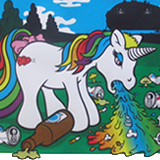|
My Imaginary GF posted:I give a gently caress about individuals who are most likely to make money for business owners and generate sales taxes, of which pedestrians generate a higher quantity. Why the gently caress don't more folk care about the gently caress'n money in a sustainable and environmentally friendly manner? Because most people don't care about that kind of thing. If I don't shop there or own a business there, why would I care about it enough to want to snarl up traffic and increase my travel time through the intersection?
|
|
|
|

|
| # ? May 21, 2024 04:35 |
|
My Imaginary GF posted:I give a gently caress about individuals who are most likely to make money for business owners and generate sales taxes, of which pedestrians generate a higher quantity. Why the gently caress don't more folk care about the gently caress'n money in a sustainable and environmentally friendly manner? Here's where the math gets involved. I made an effortpost months ago about balancing safety vs. efficiency. If we only care about efficiency, we build infinitely wide roads with no speed limits. If we only care about safety, we lock people in their houses. In the real world, we strive to strike a balance, and the simple truth is that there is no one road layout that fits every situation. In a spread-out suburban area that's not accessible to pedestrians, there's no point to having a 20-foot-sidewalk and cramming a 40,000 ADT into two lanes. 99.99% of your traffic is going to be vehicular. With great bike and ped facilities, you might push that down to 99.90%. On the other hand, in an urban area with high density and a grid-based redundant street network, changing the road configuration might change it from 80% to 50% without too much hassle. It's all situation dependent. Now for two pet peeves of mine: First, pedestrians aren't the only group of travelers who have fatalities. A pedestrian life is not inherently worth more or less than someone on a motorcycle or driving a semitrailer or riding a horse. Right now, in the last year or two, fatality rates for motorists have been skyrocketing. I'm not sure about peds and bikes; latest data I saw showed a steady decrease, but that was just for one state. We have serious systemic safety concerns, and just throwing money at one group of users isn't going to make the system as a whole any safer. When you consider that there's limited funding available for this stuff (another chagrin of mine), you can probably understand why a DOT would rather spend $50,000 putting centerline rumble strips on 50 miles of a busy road and save a life or two every year than redoing the road network downtown for $10 million for a similar fatality reduction. Second, the word "sustainable" is meaningless. Transportation is inherently unsustainable. Human life is inherently unsustainable. It's just an awful word all around. You can consider degrees of sustainability, I suppose, but saying one thing is sustainable and another is not is incorrect. ----- I am putting this in a separate section because it's tangentially related but I have no idea whether it's true or not. Hopefully someone in the thread has done research on it and can share some real data. There is an assumption that any kind of self-propelled vehicle is going to be less environmentally friendly than walking or biking. But humans emit CO2 as well. I used to think that it was really stupid to consider the CO2 humans emit when under exertion, but someone said in another thread that bicyclists emit about 90g/km of CO2 above the normal human resting metabolic rate. This is compared to something like ~120g/km of CO2 for a passenger car. So if those numbers are correct, overall CO2 emissions would be lower if you carpooled than if you rode a bike. The poster didn't cite any numbers for walking or jogging, but they did mention that mass transit was much, much lower in CO2 emission. Two big assumptions here: one is that it only counts the fuel the car burns, not the resources used to make it or to build facilities for it. I guess if you bought your car used, that would be less of an issue. We'd also have to consider the bicyclist - if they're eating imported foie gras and drinking triple-distilled Tibetan spring water, those calories they're burning will have a much higher footprint than just the CO2 emitted through metabolism. The second big assumption is that the car is burning gasoline. Ironically, considering the power grid here in New England is mostly coal and oil, an electric car would produce more emissions than a gas-burning car. But in places with cleaner power grids, we could cut that 120 g/km significantly with electric vehicles. I get the feeling you need a doctorate to make an informed decision about this stuff. Has anyone done a proper cradle-to-the-grave environmental impact analysis of the various modes of transportation? Edit: Math Cichlidae fucked around with this message at 02:50 on May 19, 2016 |
|
|
|
Doesn't car exhaust puke out a significant number of unpleasant chemicals, not just co2? That'd certainly be one important factor.
|
|
|
|
|
Javid posted:Doesn't car exhaust puke out a significant number of unpleasant chemicals, not just co2? That'd certainly be one important factor. Yeah, absolutely. The post I read only mentioned CO2. We'd have to look at NOx, CO, and particulates as well. Hope your populace doesn't drive a lot of Volkswagens... Edit: That's another subject that deserves a discussion of nuance. As part of the NEPA process, we look at the total emissions footprint of a road network for the build alternative versus the no-build. In order to protect the health of the people who live in the project area, a major objective is to improve air quality, and if you can't improve air quality vs. the no-build, that's going to be judged very harshly. In our project, I'll almost certainly be fighting that. My procedure was to keep intersection size at an absolute minimum, so long as they don't back up onto the freeway. As a result, the overall LOS gets worse vs. the no-build, and emissions are significantly higher. That's going to be a tough sell to the EPA. But I'm willing to fight that fight. I don't want people to get the impression I'm all, "hrr peds bad, cars good." This project is in a small urban area (120k people) and its density is sufficient that it's well worth removing some traffic lanes to add bike facilities and wider sidewalks. VVVVV Haha don't mention the obesity thing on Tumblr. More and more, it seems like being obese is the favored state in the US. Cichlidae fucked around with this message at 03:16 on May 19, 2016 |
|
|
|
And noise. And hasn't the effect of high bicycle use on obesity numbers been shown? Boiling it down to "only" a slightly lower co2 number seems like one way to cheese the stats to favor cars.
|
|
|
|
|
Cichlidae posted:Here's where the math gets involved. I made an effortpost months ago about balancing safety vs. efficiency. If we only care about efficiency, we build infinitely wide roads with no speed limits. If we only care about safety, we lock people in their houses. In the real world, we strive to strike a balance, and the simple truth is that there is no one road layout that fits every situation. In a spread-out suburban area that's not accessible to pedestrians, there's no point to having a 20-foot-sidewalk and cramming a 40,000 ADT into two lanes. 99.99% of your traffic is going to be vehicular. With great bike and ped facilities, you might push that down to 99.90%. On the other hand, in an urban area with high density and a grid-based redundant street network, changing the road configuration might change it from 80% to 50% without too much hassle. It's all situation dependent. James The 1st fucked around with this message at 04:44 on May 19, 2016 |
|
|
|
Cichlidae posted:Block numbering is a strange and foreign concept to those of us in New England. As a former pizza delivery driver...the idea of a city without block numbers terrifies me. In the days before conveniently having maps on my phone I was able to easily figure out where a house was within seconds once I knew the block # and where the street was. Not to mention if it was on the north/south, east/west side depending on if it was an odd or even number.
|
|
|
|
Cichlidae posted:I used to think that it was really stupid to consider the CO2 humans emit when under exertion, but someone said in another thread that bicyclists emit about 90g/km of CO2 above the normal human resting metabolic rate. This is compared to something like ~120g/km of CO2 for a passenger car. So if those numbers are correct, overall CO2 emissions would be lower if you carpooled than if you rode a bike. Something seems very off here, maybe even order-of-magnitude off. Let's say we have a small, very fuel-efficient car with only an internal combustion engine so let's say it gets say 40 miles per gallon. Gasoline is just refined hydrocarbon and the car does a good job of converting that plus air into Water, Nitrogen, and CO2. A gallon of gas contains roughly 30000 calories worth of energy - and the CO2 produced over that 40 miles should be roughly proportional to the energy converted. A good amateur cyclist can do 40 miles in a few hours without heavily adjusting their caloric intake for the day. The food they consume is not refined hydrocarbon, but even if it was, they're only going through 1500-2500 calories worth. No matter how much a cyclist is huffing and puffing or how much of the day they take on that ride, there's no way they could process, let alone expel the 30000 calorie equivalent of CO2 in a day. This lines up with the amount of work being done by each - a 2000 lb car/human combo vs as 200 lb human/bike combo. There's another thing that seems off about those numbers: Does that 120 g/km mean just what comes out of the tailpipe or does that include what a human expels just by sitting there. Because even if that 90g/km is correct, I'm not sure it would be that much lower for a human just sitting there.
|
|
|
|
Yes I believe there is a difference in "sustainability" between different CO2 sources. Releasing carbon that was fixed into material and stored underground millions of years ago would be different than releasing carbon that was fixed a few months ago, since the recent stuff (from food etc.) is part of the active cycle, while the ancient stuff is effectively new stuff being introduced into the atmosphere.
|
|
|
|
|
Alkydere posted:As a former pizza delivery driver...the idea of a city without block numbers terrifies me. In the days before conveniently having maps on my phone I was able to easily figure out where a house was within seconds once I knew the block # and where the street was. Not to mention if it was on the north/south, east/west side depending on if it was an odd or even number. My street always confused pizza delivery drivers: the houses went 32, 34, 40, 38, 36. We had the house number on our mailbox and front door, but we still had pizza deliveries getting lost maybe a third of the time. We kids eventually learned to just sit out on the curb and wait for them. Skeesix posted:Something seems very off here, maybe even order-of-magnitude off. Let's say we have a small, very fuel-efficient car with only an internal combustion engine so let's say it gets say 40 miles per gallon. Gasoline is just refined hydrocarbon and the car does a good job of converting that plus air into Water, Nitrogen, and CO2. A gallon of gas contains roughly 30000 calories worth of energy - and the CO2 produced over that 40 miles should be roughly proportional to the energy converted. Thanks, I'll question that guy if he makes the same assertion again.
|
|
|
|
I don't know how anything ever gets delivered in places in asia that use the whole "give super-block a block address then number each building within the block and it's maze of streets in the order it was built" system.
|
|
|
|
My Imaginary GF posted:Any literature on the economic and health impacts of road diets? I'd like to turn 70 feet of asphalt into 40 feet. See the latest post in the urban planning thread, which includes descriptions and citations on road diets.
|
|
|
|
In BYOB no less 
|
|
|
|
I remember a few months ago someone made an urban planning thread but I never really followed it. It... some how ended up in BYOB???
|
|
|
|
Over here Domino's delivers pizza by bicycle.
|
|
|
|
John Dough posted:Over here Domino's delivers pizza by bicycle. The local Domino's here in this section of Boston has delivered pizza by bike to us a couple of times. But then we're only like a 0.8 mile bike ride from the store
|
|
|
|
Cichlidae posted:My street always confused pizza delivery drivers: the houses went 32, 34, 40, 38, 36.
|
|
|
|
There's actually nothing wrong with CO2.
|
|
|
|
Possible bias noted
|
|
|
|
|
Carbon dioxide posted:There's actually nothing wrong with CO2. For years my company was labeling CO detectors as CO2 detectors. Gotta monitor dangerous CO2 levels in confined spaces after all.
|
|
|
|
Skeesix posted:Something seems very off here, maybe even order-of-magnitude off. Let's say we have a small, very fuel-efficient car with only an internal combustion engine so let's say it gets say 40 miles per gallon. Gasoline is just refined hydrocarbon and the car does a good job of converting that plus air into Water, Nitrogen, and CO2. A gallon of gas contains roughly 30000 calories worth of energy - and the CO2 produced over that 40 miles should be roughly proportional to the energy converted. These calculations seem as dodgy as the original statement that cars are almost as efficient as bicyclist. quote:they're only going through 1500-2500 calories worth James The 1st posted:Isn't the CO2 from human breathing part of the natural carbon cycle though, while the CO2 from burning oil is extra that overloads the cycle?[/url] If we all grew our own food fertilized with nightsoil, yes. But the food we actually eat is grown with oil based fertilizers.
|
|
|
|
Interesting thing to consider. I did some quick research for numbers and came up with the following: Assume -Biker at 30mph burns roughly 60 kcal/mi. This is very fast, riding slower burns less (due to lower wind resistance) but I'm staying conservative -All calories burned come from simple sugar which is 40% carbon -All carbon is broken down 100% into CO2 -Sugar has 4 kcal/g 60 cal/mi X 0.6214 mi/km X 0.25 g sugar/cal X 0.4 g C/g sugar X 3.667 g CO2/ g C = 13.7 g CO2/ km on a bike. The EPA estimates gasoline powered cars emit 8887 g CO2/ gal. If we assume a super efficient car @ 60 mpg: 8887 g CO2/gal ÷ 60 mi/gal X 0.6214 mi/km = 92.0 g CO2 / km. A more reasonable bike speed of 15 mph burns 30 cal/mi resulting in 6.9 g CO2 / km. A more reasonable car gets 35 mpg (still good) and results in 157.8 g CO2 / km. Myth busted? spf3million fucked around with this message at 20:03 on May 19, 2016 |
|
|
|
I dunno I believe the guy who thinks a two ton car uses less power to move around than a 25lb bicycle. (The car also has a human being in it producing CO2).
|
|
|
|
I should start some sort of sodastream like company and harness all the co2 getting pumped out of cars and people. Carbonated drinks for all!
|
|
|
|
Chemmy posted:(The car also has a human being in it producing CO2). Thanks to driverless cars, it won't have to!
|
|
|
John Dough posted:Thanks to driverless cars, it won't have to! --- As much as I just want to empty quote that, in so far as CO2 chat the last properly cited article I read stated that an electric vehicle with 4 passengers is more efficient than walking. Also far more time efficient but that's just wheeled vehicles in general. I think it also had good numbers for why biking is actually more efficient than walking almost 100% of the time.
|
|
|
|
|
Yeah, walking actually is generally better exercise than biking because biking is a lot more energy efficient due to the black magic of "wheels". Of course the best thing is to design our spaces and lives around not HAVING to drive everywhere. Really any sort of urban planning that results in most trips being able to be made self-powered (either walking or biking) should be the main goal, and where trips are too long for most people to get to in some sort of human-powered method, transit should bridge the gap.
|
|
|
|
quote:First, pedestrians aren't the only group of travelers who have fatalities. A pedestrian life is not inherently worth more or less than someone on a motorcycle or driving a semitrailer or riding a horse. Right now, in the last year or two, fatality rates for motorists have been skyrocketing. I'm not sure about peds and bikes; latest data I saw showed a steady decrease, but that was just for one state. We have serious systemic safety concerns, and just throwing money at one group of users isn't going to make the system as a whole any safer. When you consider that there's limited funding available for this stuff (another chagrin of mine), you can probably understand why a DOT would rather spend $50,000 putting centerline rumble strips on 50 miles of a busy road and save a life or two every year than redoing the road network downtown for $10 million for a similar fatality reduction. Second, many safety improvements that help pedestrians or cyclists also improve safety for people in cars. Getting people to drive more slowly, a common focus of hipster urban planners, doesn't only benefit people on foot or on bikes. quote:Second, the word "sustainable" is meaningless. Transportation is inherently unsustainable. Human life is inherently unsustainable. It's just an awful word all around. You can consider degrees of sustainability, I suppose, but saying one thing is sustainable and another is not is incorrect. Tl;dr for those who don't want to read up on the strong towns site, the gist is that many sprawly suburban developments can be unsustainable in the sense that they don't generate tax revenue sufficient to cover the cost of maintaining and eventually replacing their own infrastructure, so in the long run adding these new developments to the city is a net loss for their balance books. But, that's not obvious immediately because the biggest cost is replacing things, and it's decades after the initial development before that has to happen. So what often ends up happening is replacement costs for older developments are effectively funded off the tax revenue for newer developments. That works for a while, until it all comes crashing down. Cicero fucked around with this message at 04:53 on May 20, 2016 |
|
|
|
Golbez posted:Why? The houses were built decades apart by high school students and the parcels were subdivided. Cicero posted:This isn't really true. In particular, sprawly suburban development that focuses on cars above all else tends to be literally unsustainable, because it acts as a ponzi scheme. It doesn't have to be unsustainable; you could make it sustainable by raising property taxes enough to pay for infrastructure maintenance/replacement, and sometimes that ends up happening if the economy is good and property values rise. But it can certainly be unsustainable, there are some case studies linked to here: http://www.strongtowns.org/journal/2011/6/14/the-growth-ponzi-scheme-part-2.html What about development in general, any kind of development, is sustainable? Any growth rate, even 0.01%, is unsustainable. Even if you're not designing for cars, even if you're just building sidewalks and 3-story brick buildings, that concrete requires aggregate shipped from far away, Portland cement shipped from far away, maybe fly ash or petroleum-based admixtures. Bricks require digging up something's ecosystem and baking it (maybe in the sun, if you're lucky, but otherwise in a furnace), then mortar, which is just concrete without aggregate. You're using metal, which is unsustainably mined and smelted, you need farming, which isn't great for the environment no matter how you do it (especially if you need to support 10+ billion people), you need some way to ship freight long distances. It probably uses much less energy and resources than roads do, but it's not clean. I mean hell, if you want to go for the ultimate proof, entropy must always increase in a closed system. So unless we find a way to create a new sun out of nothing, we are all inevitably using up finite resources. I think it's fair to say one thing is MORE sustainable than another, though. Just not that something is straight-up "sustainable." Nothing is. (Like I noted, it's a pedantic argument.) Cichlidae fucked around with this message at 12:43 on May 20, 2016 |
|
|
|
Good time to point out that StrongTowns is about financial sustainability, not environmental. It also happens that financially sustainable development is more likely to be better for the environment than development that isn't financially sustainable. But sustainability is a
|
|
|
|
Cichlidae posted:What about development in general, any kind of development, is sustainable? Any growth rate, even 0.01%, is unsustainable. quote:I think it's fair to say one thing is MORE sustainable than another, though. Just not that something is straight-up "sustainable." Nothing is. (Like I noted, it's a pedantic argument.) Now, of course there are certain types of development that are intentionally subsidized by the rest of a city; nobody expects a homeless shelter to generate enough revenue to pay for itself. But for private development, being sustainable seems a reasonable expectation.
|
|
|
|
The idea that financially sustainable is more likely to be environmentally sustainable is ludicrous. Running completely unfiltered coal plants and heavy industry that dumps their waste outside the company fence is financially sustainable as hell, but the very opposite of environmentally sustainable.
|
|
|
|
Didn't see this mentioned yet. The newest ASCE report is out! The take-home message is we need to invest an additional $1.44T in our infrastructure by 2025 in order to avoid a $4T loss in GDP, $7T loss in business, and 2.5 million jobs. And by 2040, we need to invest an additional $5.2T in infrastructure to avoid a $14.2T loss in GDP, $29.3T loss in business, and 5.9 million jobs. Big numbers. Important numbers.
|
|
|
|
Going back a few days,Cichlidae posted:That depends on whether the state has a vulnerable users bill. In some states (CT included), if a car hits a ped, it makes no difference whether the ped was in a crosswalk or not. In a state without one, if the light is green and a ped steps off the curb and gets creamed, what happens next depends on whether there's a marked crosswalk. It's brick pattern stamped into fresh hot asphalt, painted brown, and then painted with white retroreflective lines (as opposed to the disastrous attempt to use actual brick crosswalks which was [url=https://goo.gl/maps/5u9Mt7H2yST2] unsuccessfully paved over.) It looks nice and appears to be MUTCD compliant.
|
|
|
|
A dude made some videos about people in city council meetings raging about bike lanes. http://streets.mn/2016/05/24/st-paul-bike-lane-trilogy/
|
|
|
|
Who likes renders/animations? Victorian government agencies for sure: Punt Road/Swan Street continuous flow intersection design is revealed: Video - https://www.facebook.com/DanielAndrewsMP/videos/1070342239696978/ (Can't find a youtube link so facebook it is, sadly) Google maps of the intersection here. While the T junction intersection (Brunton Avenue) directly to the North on the other side of the rail bridge/Richmond Station will also be upgraded, I believe at the same time as these works. Two more continuous flow intersections along Punt Road/Hoddle Street will be built too, further north while further south, south of the Yarra RIver plans are slowly being made to expand Punt Road via (partial)compulsory property acquisition, but that probably won't happen for quite a while yet. Screencaps from the above video (with my added street names)  And 1km West from that intersection up Olympic Bvld, the Swan Street Bridge upgrade: https://www.youtube.com/watch?v=kns1U6fQraQ This will really help as Batman Avenue is a toll road, running from the edge of the CBD to the Domain Tunnel portal on the M1, so lots of traffic gets banked up in the turning lane when they want to avoid the toll road and go straight down Olympic Bvld/Swan Street. Both projects were funded in last months state budget. Edit: And for rail, the Mernda Rail Extension (8km) released the project design and have a new video: https://www.youtube.com/watch?v=4qoedHkjt88 Mostly rail in trench on at grade but a few bridges over existing roads and a creek. Project page: http://levelcrossings.vic.gov.au/merndarail Even local city councils are getting in on animated project videos! Knox City Council have this for the Bayswater (nowhere near the bay or water) station rebuild and two level crossing removals: https://www.youtube.com/watch?v=HjVgdN3nMFg Bayswater in googlemaps with the level crossings at Mountain Highway and Scorsby Road going and the station between the two being rebuilt. Project overview: http://levelcrossings.vic.gov.au/crossings/bayswater Even the federal minister for the area stepped in saying reducing Mountain Hwy to two lanes in each direction was really bad and awful, except for the fact there has been no traffic growth along that segment for a few years and with the level crossings removed two lanes will suffice with no delays for trains. Also the fact it narrows to two lanes about 400 meters away anyway at the Scorsby Road intersection... And a project update video: https://www.youtube.com/watch?v=4Ftj3Yid7Jc Some locals wanted rail under an at grade road but because there are stabling areas and a maintenance facility for the train line there the road has to be elevated. 
drunkill fucked around with this message at 11:24 on May 26, 2016 |
|
|
|
Is there basically a Michigan left going on in that intersection? Wrong-side driving hurts my head.
|
|
|
|
Eskaton posted:Is there basically a Michigan left going on in that intersection? Wrong-side driving hurts my head. 
Varance fucked around with this message at 03:17 on May 27, 2016 |
|
|
|
It is essentially just a really elongated hook turn, which we have plenty of in the CBD (and a few outside of it too) to stop cars blocking tram lanes. https://en.wikipedia.org/wiki/Hook_turn Also, finally, Vicroads have installed a rubber early warning gantry at an recently imfamous bridge here. I think somewhere like 100 trucks and vans/buses have hit the protection bar infront of the bridge over the last 6 years. It is an abnormally low bridge for the area, because there is a tram line (and tram depot) ontop of it and they can't lower the road to give more clearance because the land is only a metre above water level. http://www.heraldsun.com.au/news/vi...83048b628e84b0c https://twitter.com/3AW693/status/736002219678404612 drunkill fucked around with this message at 06:21 on May 27, 2016 |
|
|
|

|
| # ? May 21, 2024 04:35 |
|
https://www.youtube.com/watch?v=btOE0rcKDC0 This is very satisfying. Dutch build a "tunnel" in a weekend.
|
|
|








































